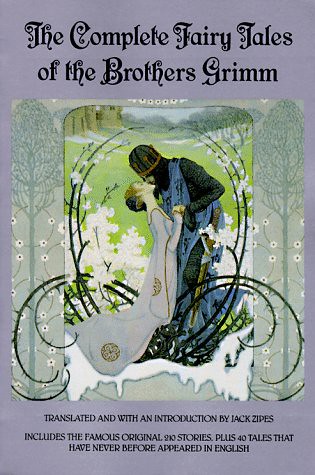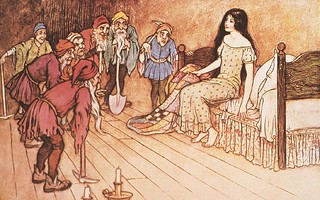 Thanks to Disney, every child in America knows the stories of Snow White, Rapunzel, and Cinderella. Disney portrays these stories as romantic tales that warm the heart of every young girl who one day wishes to find her own “Prince Charming”. However, these tales have much darker beginnings. The fairytales listed above, and many other well known stories, were published by Jacob and Wilhelm Grimm in 1812. The collection of these stories is commonly known as Grimm’s Fairy Tales but was originally published under the title Children’s and Household Tales. The fairy tales’ popularity does not stop at Disney; “So far the collection has been translated into more than 160 languages, from Inupiat in the Arctic to Swahili in Africa. In the United States book buyers have their choice of 120 editions. As a publishing phenomenon the Grimms’ opus competes with the Bible. And the stories and their star characters continue to leap from the pages into virtually every media: theater, opera, comic books, movies, paintings, rock music, advertising, and even fashion. The Japanese, perhaps the most ravenous of all the Grimms’ fans, have built two theme parks devoted to the tales” (nationalgeographic.com).
Thanks to Disney, every child in America knows the stories of Snow White, Rapunzel, and Cinderella. Disney portrays these stories as romantic tales that warm the heart of every young girl who one day wishes to find her own “Prince Charming”. However, these tales have much darker beginnings. The fairytales listed above, and many other well known stories, were published by Jacob and Wilhelm Grimm in 1812. The collection of these stories is commonly known as Grimm’s Fairy Tales but was originally published under the title Children’s and Household Tales. The fairy tales’ popularity does not stop at Disney; “So far the collection has been translated into more than 160 languages, from Inupiat in the Arctic to Swahili in Africa. In the United States book buyers have their choice of 120 editions. As a publishing phenomenon the Grimms’ opus competes with the Bible. And the stories and their star characters continue to leap from the pages into virtually every media: theater, opera, comic books, movies, paintings, rock music, advertising, and even fashion. The Japanese, perhaps the most ravenous of all the Grimms’ fans, have built two theme parks devoted to the tales” (nationalgeographic.com).

Jacob and Wilhelm Grimm
As stated before, the brothers’ tales are far grimmer than Disney animators would have us believe. The dark and often violent scenes in the stories have led to the challenging, and even banning, of the tales and the collection.
In 1989 California school districts banned Little Red Riding Hood, one of the many tales  from the Brothers Grimm, from the shelves of the elementary schools in that district. The superintendent for the district argued that the story sent mixed messages regarding the consumption of alcohol. In the story “little red” carries a bottle of wine, among other items, to her grandmother’s house where she eventually confronts the big bad wolf. At this point in the tale the reader knows that the wolf attacked and ate the grandmother and disguised itself as her to trick the young girl. Ignoring the tales more violent scenes, the district banned the book in order to protect its readers from the adverse effects of alcohol. It should be noted that none of these adverse effects are depicted in the story.
from the Brothers Grimm, from the shelves of the elementary schools in that district. The superintendent for the district argued that the story sent mixed messages regarding the consumption of alcohol. In the story “little red” carries a bottle of wine, among other items, to her grandmother’s house where she eventually confronts the big bad wolf. At this point in the tale the reader knows that the wolf attacked and ate the grandmother and disguised itself as her to trick the young girl. Ignoring the tales more violent scenes, the district banned the book in order to protect its readers from the adverse effects of alcohol. It should be noted that none of these adverse effects are depicted in the story.
Again in 1994 an Arizona school district banned the entire Brothers Grimm collection from all classrooms below the 6th grade. The Arizona superintendent argued the books should be banned due to “excessive violence, negative portrayals of female characters, and anti-Semitic references common throughout the fairy tale narratives” (bannedbooksweek.com). Unfortunately he did not cite which specific tales promoted these negative ideals.
 Graphic violence is the most commonly cited reason for challenging the Grimms’ tales. For example, Little Snow White, commonly known as Snow White and the Seven Dwarves, portrays a very violent scene in which the wicked queen orders her huntsman to hunt down the runaway Snow White and cut out her heart. Feeling compassion towards the young girl, the huntsman deceives the wicked queen by offering her a boar’s heart in place of the human heart. The evil queen then proceeds to eat the heart that she believes belonged to Snow White. This graphic scene, among others, led parents to challenge the use of the tale in a Florida elementary school. Since 1992, students at that school are required to show parental permission slips to even view the collection. The story is no longer used as an educational tool to teach folklore as literature.
Graphic violence is the most commonly cited reason for challenging the Grimms’ tales. For example, Little Snow White, commonly known as Snow White and the Seven Dwarves, portrays a very violent scene in which the wicked queen orders her huntsman to hunt down the runaway Snow White and cut out her heart. Feeling compassion towards the young girl, the huntsman deceives the wicked queen by offering her a boar’s heart in place of the human heart. The evil queen then proceeds to eat the heart that she believes belonged to Snow White. This graphic scene, among others, led parents to challenge the use of the tale in a Florida elementary school. Since 1992, students at that school are required to show parental permission slips to even view the collection. The story is no longer used as an educational tool to teach folklore as literature.
“The stories and moral lessons contained in fairy tales are often anything but—children are devoured, thrown into ovens, imprisoned unjustly, and seduced by wolves. Murder, violence and abuse by adults appears commonplace throughout the tales of Brothers Grimm” (New York Public Library). However, that does not mean that children cannot learn valuable moral lessons from the stories. To this day the fairy tale collection faces fierce backlash from parents, teachers, legislators, and religious groups. Should these fairy tales be banned? The answer depends on many things, you should decide for yourself if the stories are appropriate for your children or students. This case stands as an enigma, most readers of this blog would be shocked by the banning of our beloved children’s books like Winnie-the-Pooh and Alice in Wonderland, and I believe that the Grimm’s tales should be examined closely before we argue for or against banning.
To examine these tales for yourself please visit the Department of Special Collections and University Archives located on the 5th floor of McFarlin library. We are open from 8-5 Monday-Friday.
Remember to check back next week to read why The Wizard of Oz and other stories of Oz have been banned and challenged throughout history.
